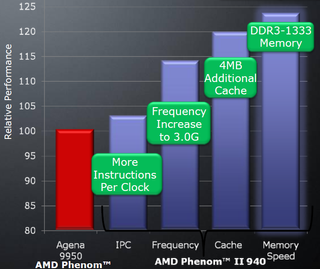AMD Phenom II X4: 45nm Benchmarked
Performance-Enhancing Changes

Compared to the first-generation Phenom processors, the Phenom II is faster clock for clock. AMD cites four key areas that were enhanced, in addition to the silicon-level transistor changes previously mentioned, that help Phenom II deliver increased processing speeds.
1. More Instructions Per Clock Cycle
The Phenom is built upon the Stars architecture, but its implementation includes numerous improvements undertaken to increase the number of instructions that can be handled per clock cycle. No new instructions or multimedia extensions were needed to achieve this speed-up. By comparison, the first-generation Phenom processors added support for the SSE4a multimedia extensions, which the Athlon 64 X2 processors do not share.

.
2. Increase In Clock Rate
As a result of the switch from 65 nm to 45 nm manufacturing, the voltage needed to drive Phenom II is down significantly. In combination with an improvement to the base micro-architecture, this gave AMD a license to increase the clock rate. Whereas the first-generation Phenoms topped out at 2.6 GHz, the latest Phenom IIs start at 2.8 and scale to 3.0 GHz.
3. Increase The L3 Cache To 6 MB
Stay on the Cutting Edge
Join the experts who read Tom's Hardware for the inside track on enthusiast PC tech news — and have for over 25 years. We'll send breaking news and in-depth reviews of CPUs, GPUs, AI, maker hardware and more straight to your inbox.

It just wasn’t an option for AMD simply to arm the first-generation Phenom with a larger L3 cache. The power requirements of those 65 nm transistors would have undoubtedly boosted consumption past the 140 W mark. But current draw was sufficiently reduced in switching to 45 nm technology to enable AMD to augment the L3 cache size from 2 MB to 6 MB. In any case, the separate 512 KB caches provided for each individual core did not change with this redesign, nor did the 64 KB L1 instruction and data cache areas.
4. Support For DDR3-1333 RAM
Another contributor to the Phenom II’s improved performance comes from its support for DDR3 RAM, though it won’t be available for a few months yet. AMD plans to introduce the Phenom II with this RAM interface together with the market introduction of its Socket AM3 architecture.
Current page: Performance-Enhancing Changes
Prev Page Technical Details Next Page Dragon Platform And Socket AM2+-
firedogevan why focus on the q6600... wouldn't the q9550 or 9650 be a more accurate comparison given their respective locations in the product lineup?Reply -
dechy Yeah, the price comparison table should of included a Q9550, which costs same as i7 920 but with the lower mobo/ram combo price.Reply
Ends up being the same price as the AMD bundle, but with a good more performance... there goes the whole "AMD price/performance" aspect of this chip. -
one-shot Great review. Maybe some overclocking later? There were some pretty high claims about its overclocking potential. I'll wait for AM3 before I retire my E6750.Reply -
The Q9xxx series would trump the PhenomII in all the categories listed above. THG, it was downright *criminal* to have not included the Yorkfield chips in your performance per dollar and performance per watt analysis.Reply
-
nashville hey bert/tom's:Reply
good write up: thought id comment on i7 watts:
"we measured the power consumption directly from the 12 volt rail that supplied the CPU", i read somewhere the only i7 core logic gets power from 12v rail, the uncore/cache part somewhere else. if this is true, you going to do another measurements? -
kirvinb I'm so happy to see Intel has some competetion. While these new processors are not mind blowing, they offer some decent performance at the price given. I am sure this will lower the price of the q9400 and q9550, which is exactly what I want to see. Maybe even the i7s price will lower and maybe we will be back in the good days..where intel and amd flipped sides of the powerhouse like every 6 months..!! Good Write Up..Reply -
jj463rd On the forums someone mentioned "why did they use DDR2-800 RAM when DDR2-1066 would give better performance for the Phenom II".Wouldn't this skew the benchmarks by a little bit (perhaps 2 to 3%)?Reply
Most Popular

